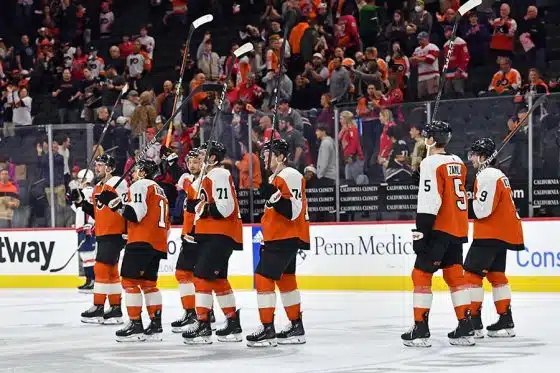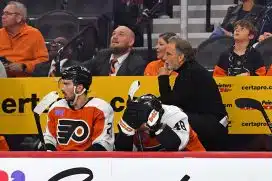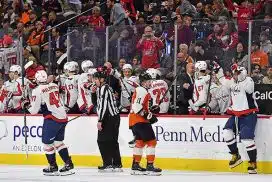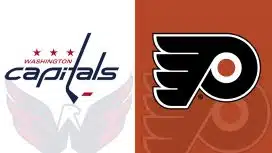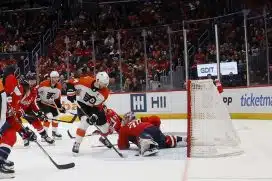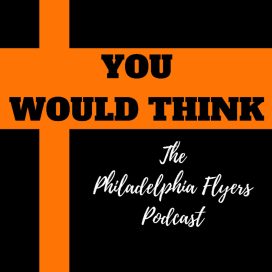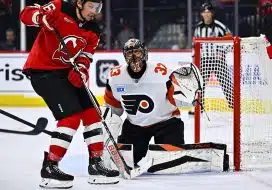By Kevin Durso, Sports Talk Philly editor
In terms of offseasons moves, the Flyers offseason was going to be rather predictable and boring. Aside from making the necessary re-signings and adding a free-agent goalie, the Flyers weren’t going to be in the market for a big splash signing or trade.
But one acquisition that did create some noise was one made to the coaching staff. The Flyers hired Kris Knoblauch as the replacement for Joe Mullen. By adding the rising star on the bench, who vaulted the Erie Otters to elite status in the OHL, the Flyers are bring in a coach that is highly-regarded around the hockey world.
''Kris' teams had a lot of success on the power play, in the goal-scoring department, goals against and obviously just the success overall,'' Flyers GM Ron Hextall said following the hiring. ''We liked his personality, we feel he'll fit in really well with our group and he has a good hockey mind.''
The first thing Hextall mentioned was Knoblauch’s success on the power play, an area that the new NHL assistant coach will run from the start with the Flyers. In the short-term, Knoblauch is supposed to help improve a Flyers power play that ultimately was inconsistent.
Here’s how he can do that.
For one, Knoblauch comes in as a young member of the coaching staff at age 38, similar to the Flyers overall youth movement on the roster. Younger coach, younger players, potentially a better connection and atmosphere for development. That’s the sentiment received as Knoblauch spent four-plus seasons behind the bench for the Erie Otters, posting a 216-83-11 record and leading the Otters to the OHL Finals in 2015 and the 2017 OHL championship.
The Flyers power play wasn’t really so much in decline last season. The Flyers started the season with a 27.5 percent success rate (11-for-40) on the power play in 10 games in October. They had a 23.5 percent success rate after 32 games, the last being the 10th and final win on a 10-game winning streak. The Flyers finished the season with a 16.5 percent success rate in the final 50 games of the season, including a 10 percent success rate (5-for-50) in 15 games in March.
It was a working method that ultimately became stagnant and predictable.
Here’s where the problem was. The Flyers entries were ultimately predictable with Claude Giroux usually taking a drop pass from Shayne Gostisbehere and trying to skate into the attacking zone. Upon entry, he would stop, and try to set up along the boards at the left faceoff circle.
From there, there were really two options, look for the one-timer for Gostisbehere at the point or the cross-ice one-timer to Jake Voracek. In many cases, when the Flyers scored, it was off of a deflection by either Brayden Schenn or Wayne Simmonds or Simmonds being in front for a rebound.
Ultimately, the Flyers didn’t have options to keep the puck moving, where the most successful teams in the league on the power play were constantly cycling the puck and getting the opposing penalty kill all out of sorts.
That’s what Knoblauch could bring to the Flyers. It starts with getting a strong zone entry that doesn’t result in so many one-and-done chances or potential shorthanded breaks the other way. Additionally, trying to keep the parts moving, to get the players on the top unit in different positions instead of always being stationary in their predictable spots, could go a long way.
The Flyers will have to deal with power play personnel as well. By trading Schenn, there is a hole in the Flyers top unit that will need to be filled and the second unit last season didn’t provide much in terms of confidently adding someone to the top group.
There is no mistaking four members of the top unit. The power play will still run through Giroux, still feature Gostisbehere quarterbacking the blue line, still have Simmonds planted in front of the net and still have Voracek flanking as the second defenseman. That leaves another spot for a forward. Two candidates are certainly Jordan Weal and Travis Konecny, who each had modest success on the second power play unit late in the 2016-17 season.
Sean Couturier and Ivan Provorov figure to be part of the second unit, as will one of Weal or Konecny. That leaves two remaining spots on the second unit.
One of those players has to be a defenseman, as most teams usually put two defensemen on the second unit so they don’t get caught with four forwards on the ice when a penalty expires and gameplay returns to even strength. Radko Gudas could be a veteran presence on the power play, but it wouldn’t be a surprise to see a rookie defenseman join that group, whether someone like Robert Hagg or if Travis Sanheim were able to break into the lineup.
For the remaining forward slot, depending on how the roster shapes up, a rookie like Oskar Lindblom or Nolan Patrick could fill the spot or it could be a veteran player like Michael Raffl or Matt Read filling the final slot.
There is a lot that will go into Knoblauch’s job, from building up the units to implementing his system, but if his success at Erie and in the OHL is any indication, the Flyers power play should see improvement in the next season.
Podcast
Subscribe to the Flyerdelphia Podcast on iTunes, Google Play and YouTube.

